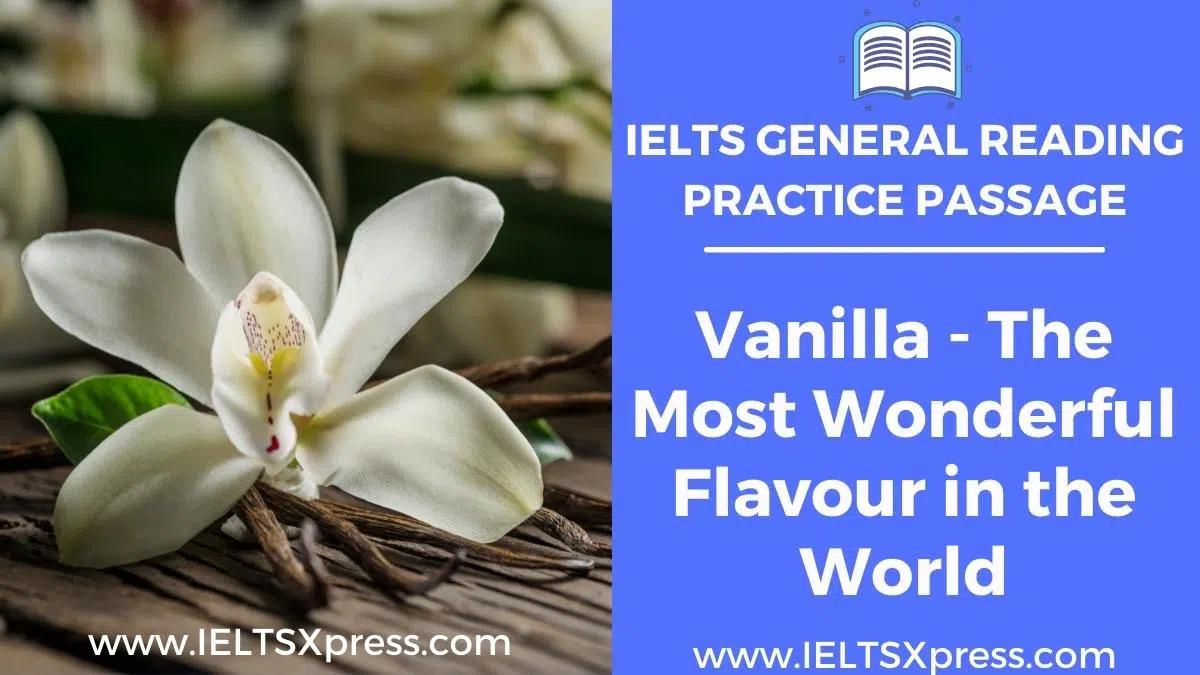Vanilla The Most Wonderful Flavor in The World IELTS General Training Reading
Reading Passage 3
Questions 28-40
Read the text below and answer Questions 28-40.
Vanilla – The Most Wonderful Flavor in The World
Vanilla is the most popular and widely used flavor in the world. And, yet, the vanilla orchid is only grown in a few countries. Below you’ll discover why these countries are ideal and how the vanilla from each region differs.
Mexico
Vanilla (Vanilla planifolia Andrews) originated in Mexico and for centuries was the exclusive secret of the native Totonac Indians, who were later conquered by the Aztecs. The Aztecs, in turn, were conquered by the Spanish forces led by Cortez in 1520. He brought vanilla pods home to Spain, thus introducing the flavorful pods to the rest of the world.
However, Mexico remained the sole grower of vanilla for another 300 years. The particular relationship between the vanilla orchid and an indigenous bee called the Melipone was crucial. It was responsible for pollinating the flowers, resulting in fruit production.
Vanilla pods should be picked when the tip begins to turn yellow. The curing process gives the pods their characteristic brown color as well as their flavor and aroma. In Mexico, farmers cure the pods by wrapping them in blankets and straw mats and then placing them in ovens for 24 to 48 hours. After that, the pods are spread outdoors to absorb heat during the day and then placed in wooden boxes overnight. Once properly cured, they are stored to further develop the flavor. The entire curing process takes three to six months, making it a very labor-intensive process.
Vanilla from Mexico has a flavor that combines creamy tones with a deep, spicy character, making it a delicious complement to chocolate, cinnamon and other warm spices. It also works wonderfully in tomato sauces.
Madagascar
Around 1793, a vanilla plant was smuggled from Mexico to the Island of Reunion, east of Africa. For almost 50 years, the production of vanilla struggled. The vines grew successfully with beautiful blossoms but vanilla pods were infrequent. Without the Melipone bee, the flowers weren’t being fertilized beyond occasional pollination by other insects. It wasn’t until 1836 that Charles Morren, a Belgian botanist, discovered the pollination link between bee and plant. And then in 1841, Edmond Albius of Reunion developed an efficient method for fertilizing the flower by hand. Now, growers could choose the best flowers to pollinate, resulting in a healthier and higher quality vanilla pod.
Eventually, the plants arrived on the nearby island of Madagascar, where hand pollination proved its worth. Assisted by the climate and rich soil, hand pollination by the country’s skilled farmers has enabled Madagascar to become the world’s top vanilla producer in quantity and, many would argue, quality.
The curing process is similar to that in Mexico with one difference. The farmers initiate the process by immersing the green vanilla pods in hot water for some time. They then store them in sweat boxes before beginning the routine of spreading them outdoors during the day and packing them away at night. The different curing method used contributes to the overall flavor of the vanilla.
The sweet, creamy and mellow flavor is the one most people identify with vanilla. This flavor and the pod’s ability to hold that flavor in both hot and cold applications make it an exceptional ‘all-purpose’ vanilla which is many people’s first choice for a wide range of sweet recipes – from cooking and baking to ice creams and buttercreams.
Tahiti
Like the other countries, Tahiti’s tropical climate makes it ideal for growing vanilla. However, Tahiti differs in the species of vanilla that is most common: Vanilla tahitensis Moore. This is the hybrid of two vanilla species introduced in the 1800s. These two species were skilfully crossed in the next few decades, to create the plump Tahitian vanilla pods we know today.
The curing process also differs from other countries’. Mature pods are first stacked in a cool place until they are completely brown (five to ten days) and then rinsed briefly in clear water, a unique characteristic of the method used in Tahiti. For the next month, growers expose the pods to the gentle morning sunlight. In the afternoon, they bind the pods in cloths and store them in crates until the next morning, to promote transpiration. Little by little, the vanilla pods lose weight and shrink. Throughout this phase, the workers carefully smooth and even out the pods with their fingers. Then after a month, the final step is to leave the pods in a shaded and well-ventilated spot for 40 days to lower their moisture content.
This species of orchid combined with Tahiti’s advantageous climate and soil results in a vanilla that has fruity and sweet tones. Tahitian vanilla is especially vulnerable to heat and is therefore best used in refrigerated and frozen desserts, fruit pies and smoothies.
Indonesia
Indonesia is the second largest producer of vanilla. However, Indonesian production methods focus on quantity over quality. Unlike other regions, where vanilla beans are picked only when ripe, Indonesian growers harvest all the beans at one time, a labor-saving adjustment.
The curing process also features production shortcuts such as the use of propane heaters to speed up drying. The use of such heat, which chemically alters the beans, essentially ‘bums off flavor components while adding a smoky tone, resulting in a less complex taste and a sharper flavor. Indonesian vanilla works well when blended with vanillas from other regions and, because it’s more economical, it makes the end product more affordable.
Questions 28-31
Look at the following statements (Questions 28-31) and the list of countries below.
Match each statement with the correct country, A, B, C or D.
Write the correct letter, A, B, C or D, in boxes 28-31 on your answer sheet.
28 The vanilla that is grown here was created from more than one type of vanilla plant.
29 This vanilla is often mixed with other types of vanilla.
30 Some people claim that this country produces the finest vanilla.
31 This vanilla goes well with both sweet and savoury ingredients.
List of Countries
A Mexico
B Madagascar
C Tahiti
D Indonesia
Questions 32-34
Choose the correct letter, A, B, C or D.
Write the correct letter in boxes 32-34 on your answer sheet.
32 What prevented countries, apart from Mexico, from growing vanilla in the 17th and 18th centuries?
A the Aztecs’ refusal to let the pods be exported
B the lack of the most suitable pollinating insect
C the widespread ignorance of the existence of the plant
D the poor condition of the vanilla pods that Cortez collected
33 What does the writer suggest was the main reason for the success of vanilla cultivation on Madagascar?
A the adoption of a particular agricultural technique
B the type of vanilla orchid that was selected
C the unique quality of the soil on the island
D the rapidly increasing number of growers
34 The writer believes that Madagascan vanilla is so popular because
A it works well in a variety of main courses and puddings.
B its pod is less likely than others to break up when it is cooked.
C its taste is widely considered to be the standard taste of vanilla.
D it is the one that is used in a number of commercial frozen desserts.
Questions 35-40
Complete the summary below.
Choose ONE WORD ONLY from the text for each answer.
Write your answers in boxes 35-40 on your answer sheet.
How vanilla pods are cured in Tahiti
Tahitian farmers start by leaving the pods to turn 35___________ all over. They then wash them quickly before the main stage of the curing process begins. They place the pods in the 36___________ during the early part of the day. Cloths are then wrapped round them and they are left in boxes overnight. This procedure encourages 37___________ . Gradually, the 38___________ of the individual pods starts to decrease. While this is happening, the farmers continue to work on the pods. They use their 39___________ to flatten them out. For the last stage in the curing process, the pods are kept in a cool place which is open to the air, so that the amount of 40___________ within them is reduced.
Vanilla The Most Wonderful Flavor in The World IELTS Reading GT Passage Answers
Practice with Expert IELTS Tutors Online
Apply Code "IELTSXPRESS20" To Get 20% off on IELTS Mock Test
28 C
29 D
30 B
31 A
32 B
33 A
34 C
35 brown
36 sunlight
37 transpiration
38 weight
39 fingers
40 moisture
Also Check: Tuning up your Leadership Skills IELTS General




